Python Dictionary to JSON: Best Practices for Beginners
- By Hansa Vaghela
- 07-11-2025
- Technology
.jpg)
In the modern world of software development, data is the backbone of every application. Whether you are building a web application, a mobile app, or a data analysis tool, managing data efficiently is critical. Python, being one of the most versatile and beginner-friendly programming languages, offers powerful tools for data handling. Among these tools, dictionaries are a fundamental data structure used to store and organize information as key-value pairs. However, storing data in memory is just one part of the puzzle. Often, applications need to share data across different systems, save it to files, or send it over the internet. This is where data serialization comes into play.
Importance of Data Serialization in Python
Data serialization is the process of converting complex data structures, like Python dictionaries, lists, or objects, into a format that can be easily stored or transmitted and later reconstructed. Think of it as translating your Python objects into a universal language that other programs, languages, or systems can understand.
Here are several reasons why serialization is crucial in Python development:
Data Storage and Persistence
Python dictionaries and other in-memory data structures exist only while your program is running. If the program stops or crashes, all the data is lost. By serializing data into a persistent format such as JSON, CSV, or binary files, you can save the current state of your application for future use. This is particularly useful for applications like configuration management, logging, or storing user preferences.
Example:
Saving user settings for a Python application as JSON allows the app to reload the same configuration when it restarts.
Data Transmission Across Networks
Modern applications are rarely standalone. They often interact with APIs, servers, and cloud services. When a Python dictionary needs to be sent over a network for example, to a web server or a mobile app it must be converted into a standard format like JSON. Serialized data ensures smooth communication between different platforms, programming languages, and systems.
Example:
A Python backend sending product data to a JavaScript frontend via a REST API relies on serialization to convert dictionaries into JSON.
Interoperability Between Programming Languages
Python is just one of many languages in the tech ecosystem. To share data between applications written in different languages (like Java, JavaScript, or C#), Python objects need to be serialized into a language-agnostic format. JSON is the most widely adopted format for this purpose because it is understood by almost every programming language.
Debugging and Logging
Serializing Python data into a human-readable format like JSON helps developers debug programs and track application state. Structured logging using JSON provides clarity over traditional plain-text logs and allows log aggregation tools to parse and visualize the data effectively.
Simplifies Data Manipulation
Serialized data, especially in JSON format, allows easy manipulation with built-in libraries in Python and other languages. This simplifies common tasks such as filtering records, extracting values, or transforming data before saving or transmitting it.
Why JSON is Widely Used
JSON, or JavaScript Object Notation, has become the de facto standard for data serialization in modern applications. Its popularity stems from several key advantages:
Human-Readable Format
JSON uses a clean, readable syntax that closely resembles Python dictionaries: {key: value}. Unlike binary serialization formats, JSON is easy to read and write, which makes it suitable for debugging and configuration files.
Example JSON:

Language Independence
JSON is platform-agnostic. Although it originated from JavaScript, it is supported natively or via libraries in almost every programming language. This makes it the ideal choice for cross-platform data exchange.
Lightweight and Efficient
JSON is a text-based format, which makes it smaller and easier to transmit over networks compared to heavier formats like XML. This efficiency is crucial in web applications where bandwidth and speed are important considerations.
Wide Adoption in Web and APIs
Nearly all modern web APIs use JSON as their primary data format. Python applications often consume and produce JSON to interact with these APIs. Learning to convert dictionaries to JSON is therefore a critical skill for Python developers.
Support for Complex Data Structures
JSON can represent arrays (lists), objects (dictionaries), strings, numbers, booleans, and null values. This versatility allows developers to serialize complex nested dictionaries and lists, making it suitable for real-world applications.
Integration with Databases and Tools
Many modern NoSQL databases, such as MongoDB and CouchDB, store data in JSON-like formats. Using JSON ensures that Python applications can interact seamlessly with these databases. Similarly, cloud services, message queues, and configuration management tools often prefer JSON.
What Is JSON?
JSON, short for JavaScript Object Notation, is a lightweight, text-based format for storing and exchanging data. Originally developed for JavaScript, JSON has become a language-independent standard for serializing structured data. It is widely used in web development, APIs, configuration files, and data storage because it is easy to read, write, and parse.
JSON represents data as key-value pairs, very similar to Python dictionaries. The keys are always strings, and the values can be strings, numbers, arrays (lists), objects (nested dictionaries), booleans, or null. Its syntax is clean and minimal, making it human-readable.
Example of JSON:
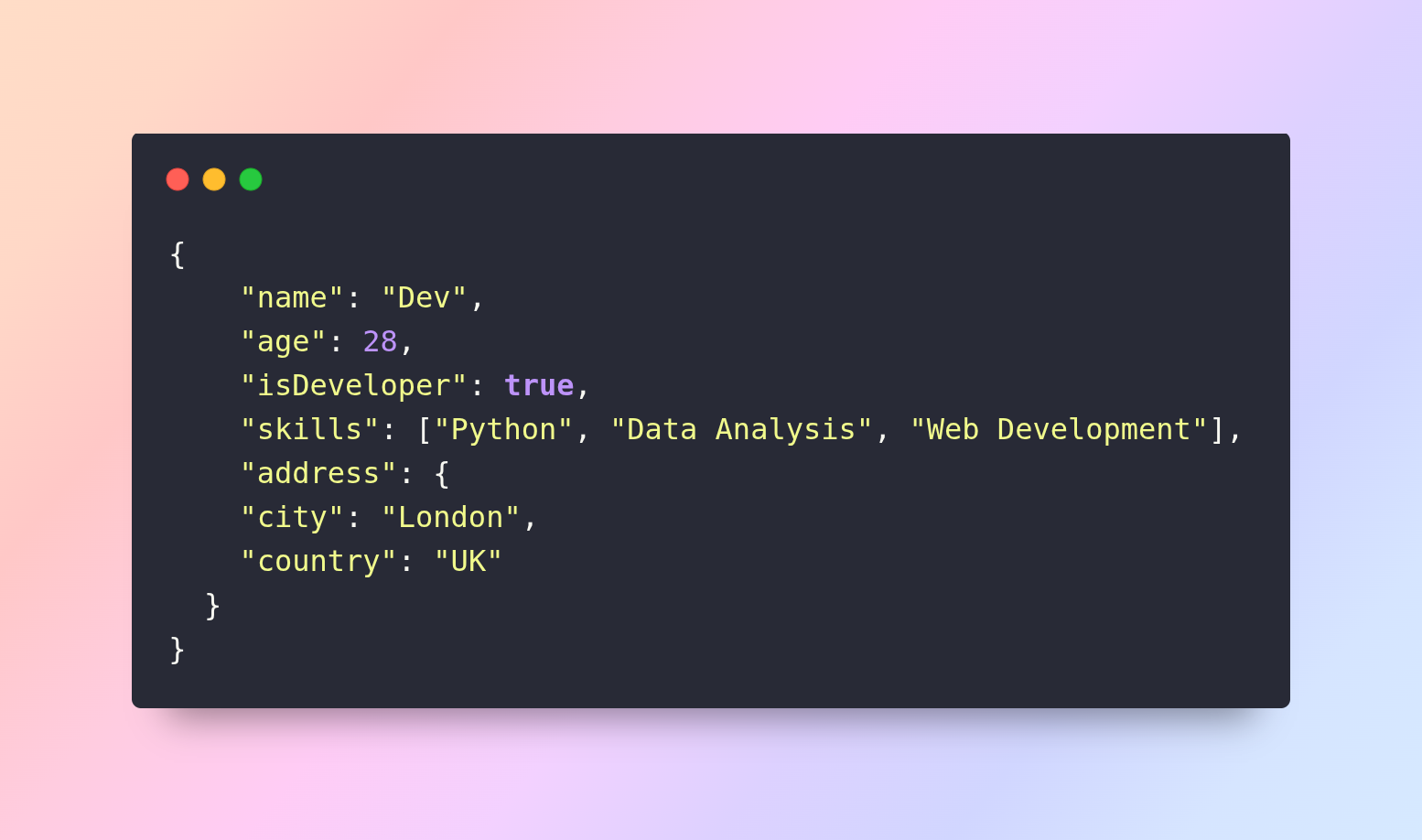
In this example:
- "name" and "age" are simple key-value pairs.
- "skills" is an array of strings.
- "address" is a nested JSON object.
- "isDeveloper" is a boolean value.
Differences Between Python Dictionary and JSON
Although JSON and Python dictionaries look very similar, there are important differences:
|
Feature |
Python Dictionary |
JSON |
|
Keys |
Can be strings, numbers, tuples |
Must be strings |
|
Values |
Can be strings, numbers, lists, dicts, tuples, sets, custom objects |
Strings, numbers, arrays (lists), objects (dicts), booleans, null |
|
Syntax |
Uses single ' or double " quotes for strings |
Only double " quotes allowed |
|
Methods |
dict.keys(), dict.items(), etc. |
JSON does not have methods; must be parsed in Python |
|
Mutability |
Mutable (can change values) |
JSON is just a text format; to modify, parse back to Python dict |
Example of Python dictionary vs JSON:
Python dict:
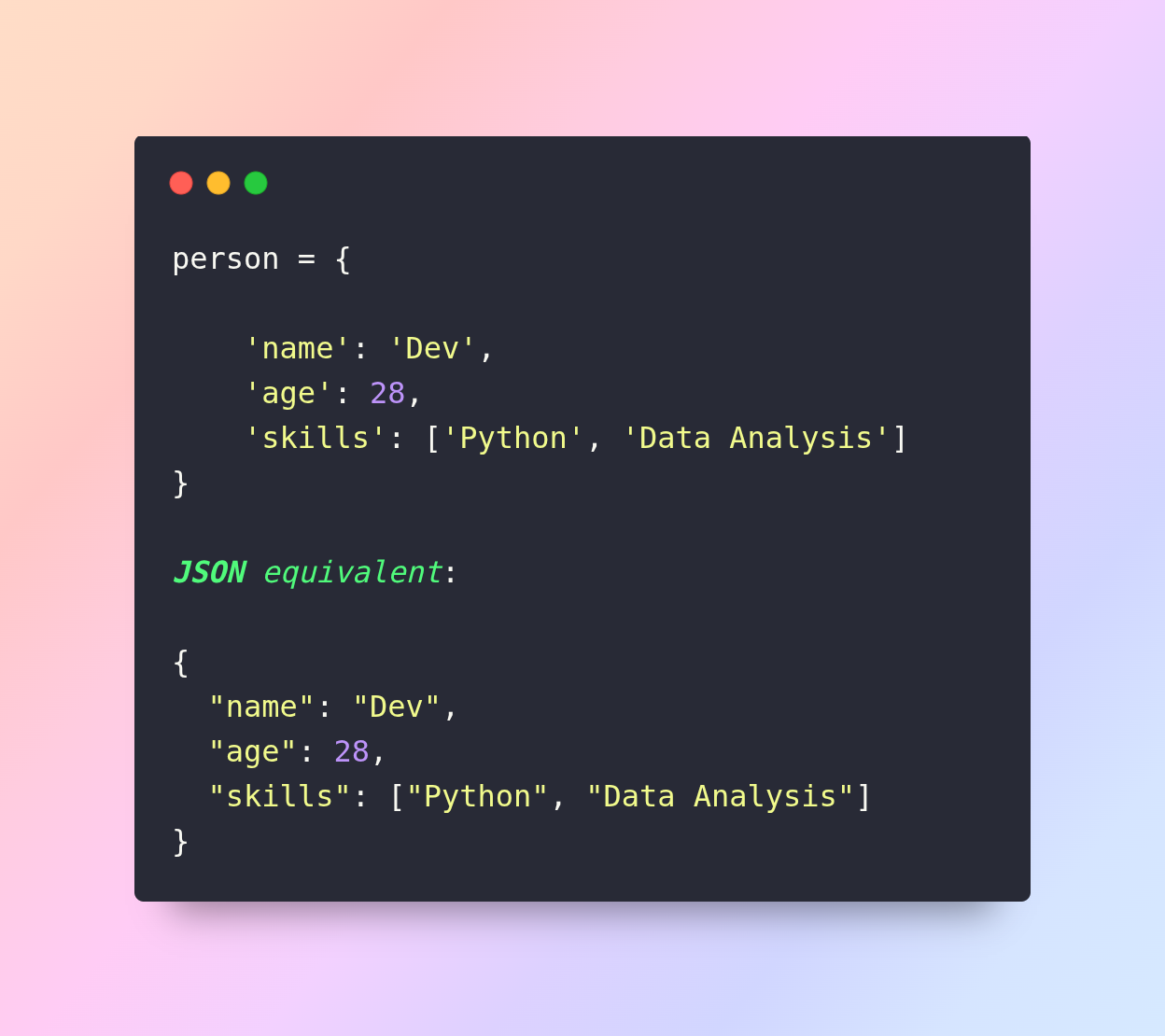
Notice the differences:
- Python allows single quotes; JSON requires double quotes.
- Python dicts can have more complex types (like tuples or sets), which JSON cannot directly store.
Supported Data Types in JSON
JSON supports a limited set of data types, designed for simplicity and compatibility:
String – Must be enclosed in double quotes.
- "name": "Dev"
Number – Integers or floating-point values.
- "age": 28
Boolean – true or false (lowercase in JSON).
- "isDeveloper": true
Array – An ordered list of values (similar to Python lists).
- "skills": ["Python", "Data Analysis", "Web Development"]
Object – A nested JSON object (similar to Python dictionaries).
- "address": {"city": "London", "country": "UK"}
Null – Represents an empty value (None in Python).
- "spouse": null
Why Convert Python Dictionaries to JSON?
Converting Python dictionaries to JSON is one of the most common tasks in modern Python development. Here’s why it’s essential:
1. Use in APIs
APIs (Application Programming Interfaces) are the backbone of modern applications. When a Python application communicates with a web service, the data must often be serialized into JSON format for sending requests or receiving responses.
Example: Sending user data to an API:
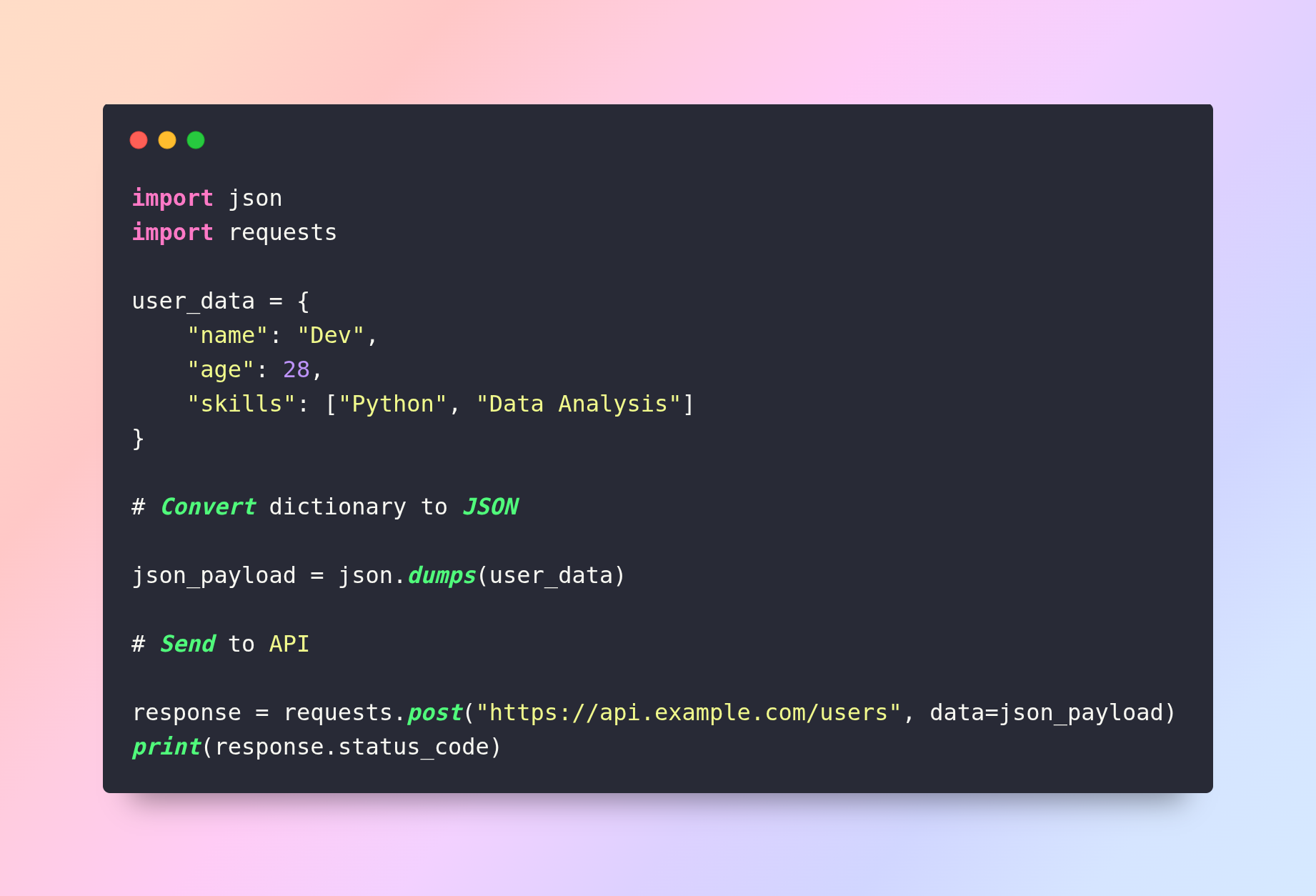
Why JSON?
- JSON is lightweight and easy to transmit over HTTP.
- Almost all APIs expect JSON because it is language-independent.
- Makes data exchange between backend (Python) and frontend (JavaScript) seamless.
2. Data Storage
Another major reason to convert dictionaries to JSON is data storage. Unlike Python dictionaries, JSON can be saved to a file and retrieved later, allowing your application to persist information between runs.
Example: Saving user data to a JSON file

- indent=4 makes the JSON human-readable.
- JSON files are portable and can be shared or backed up easily.
Use cases:
- Storing user settings or preferences
- Logging application events
- Keeping configuration files for software projects
3. Cross-Platform Compatibility
Python dictionaries exist only within Python programs. If you need to share data with other languages, frameworks, or platforms, you must use a universal format. JSON is supported almost everywhere JavaScript, Java, C#, PHP, Go, and more.
Example: Sharing data between Python and JavaScript
Python:

Why it matters:
- Enables multi-language applications
- Facilitates web and mobile app development
- Ensures consistent data formatting across platforms
Basic Conversion Techniques
Python provides the json module to handle serialization. Two main functions are used: json.dumps() and json.dump().
1. Using json.dumps() – Converting Dictionary to String
The json.dumps() function converts a Python dictionary into a JSON-formatted string. This is useful when you want to send data over APIs or process it as a string in your application.
Example:
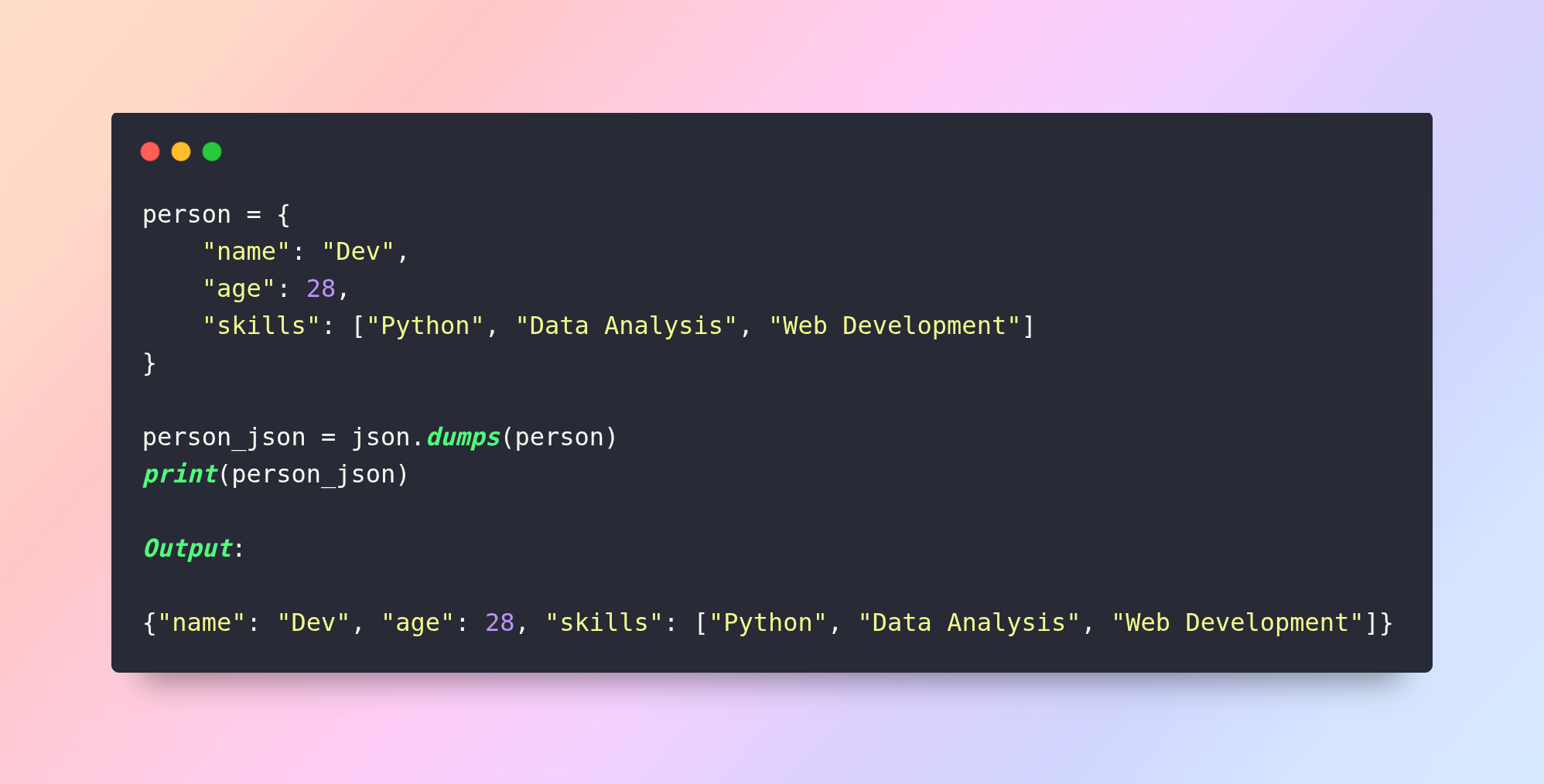
Step-by-step explanation:
- Import the json module.
- Define a Python dictionary person.
- Use json.dumps(person) to convert it to a JSON string.
- Print or use the string as needed.
2. Using json.dump() – Saving Dictionary to JSON File
If you want to save the JSON data to a file, use json.dump().
Example:
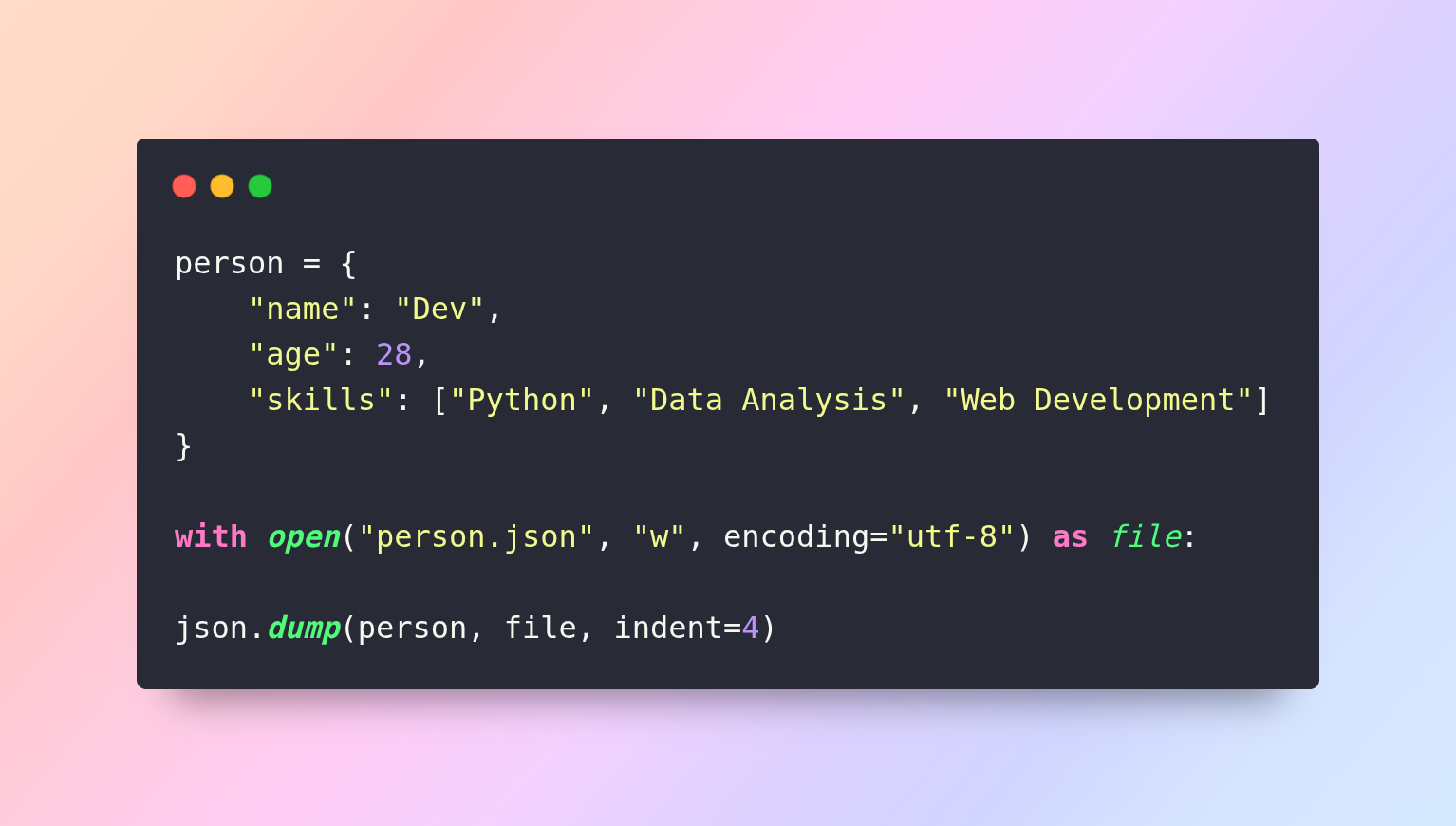
- indent=4 makes the JSON readable.
- encoding="utf-8" ensures special characters are handled properly.
Best Practices for Conversion
To make your JSON data clean, readable, and compatible, follow these best practices:
1. Readable JSON with indent
Adding an indentation makes the JSON human-readable, which is useful for debugging or configuration files.
json_string = json.dumps(person, indent=4)
print(json_string)
2. Sorting Keys
Sort keys alphabetically to maintain consistency in JSON files.
json_string = json.dumps(person, indent=4, sort_keys=True)
3. Handling Non-Serializable Objects (default Parameter)
JSON cannot directly serialize objects like sets, tuples, or custom classes. You can handle them with the default parameter:
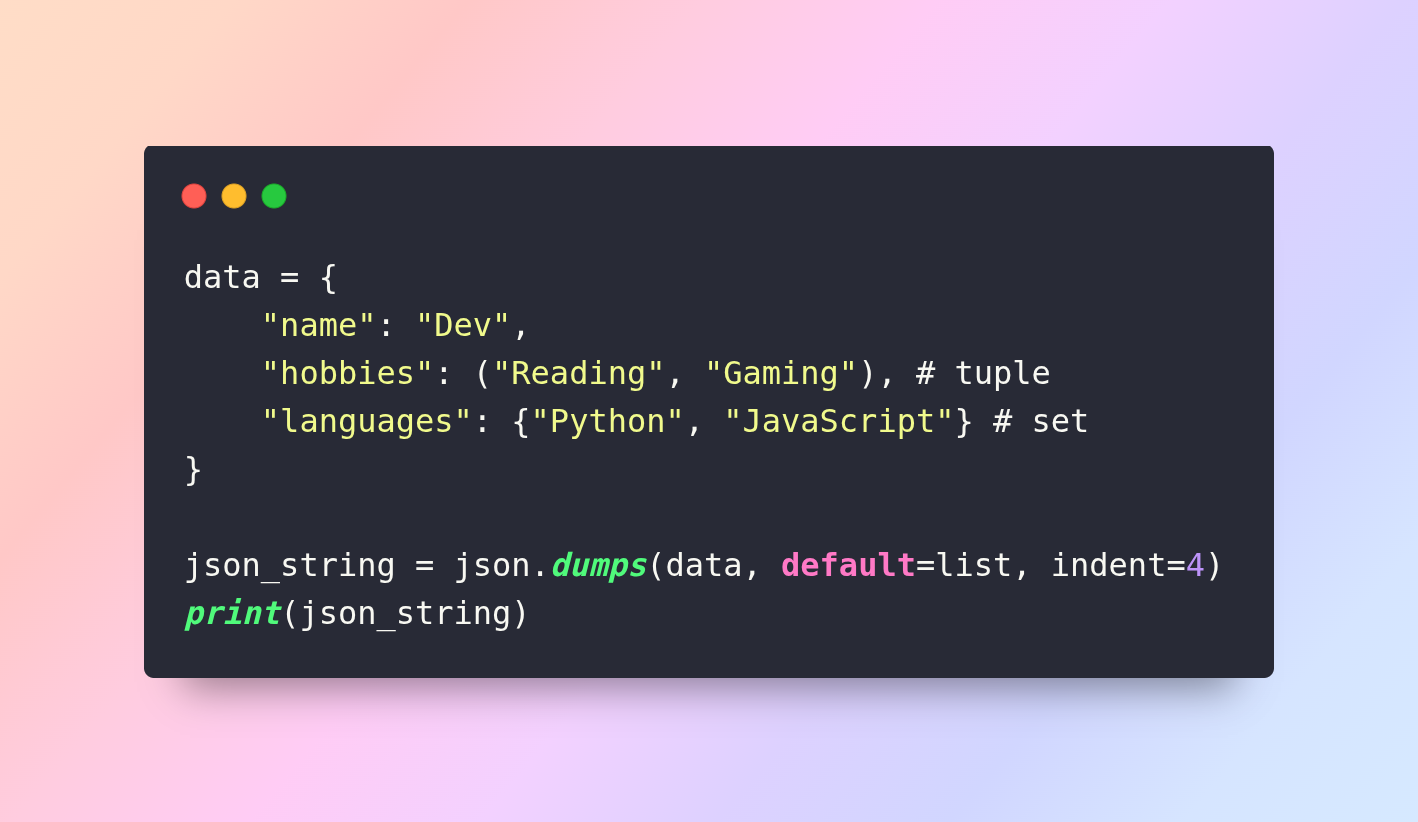
4. Ensuring UTF-8 Encoding
Always write files with utf-8 encoding to avoid errors with special characters:
with open("person.json", "w", encoding="utf-8") as file:
json.dump(person, file, ensure_ascii=False, indent=4)
5. Avoiding Circular References
Dictionaries that reference each other cannot be serialized directly. Ensure data structures are acyclic.
a = {}
b = {"ref": a}
a["ref"] = b
# json.dumps(a) will raise a TypeError
Working with Nested Dictionaries and Lists
JSON works well with nested structures. You can have dictionaries inside dictionaries or lists inside dictionaries.
Example: Nested JSON
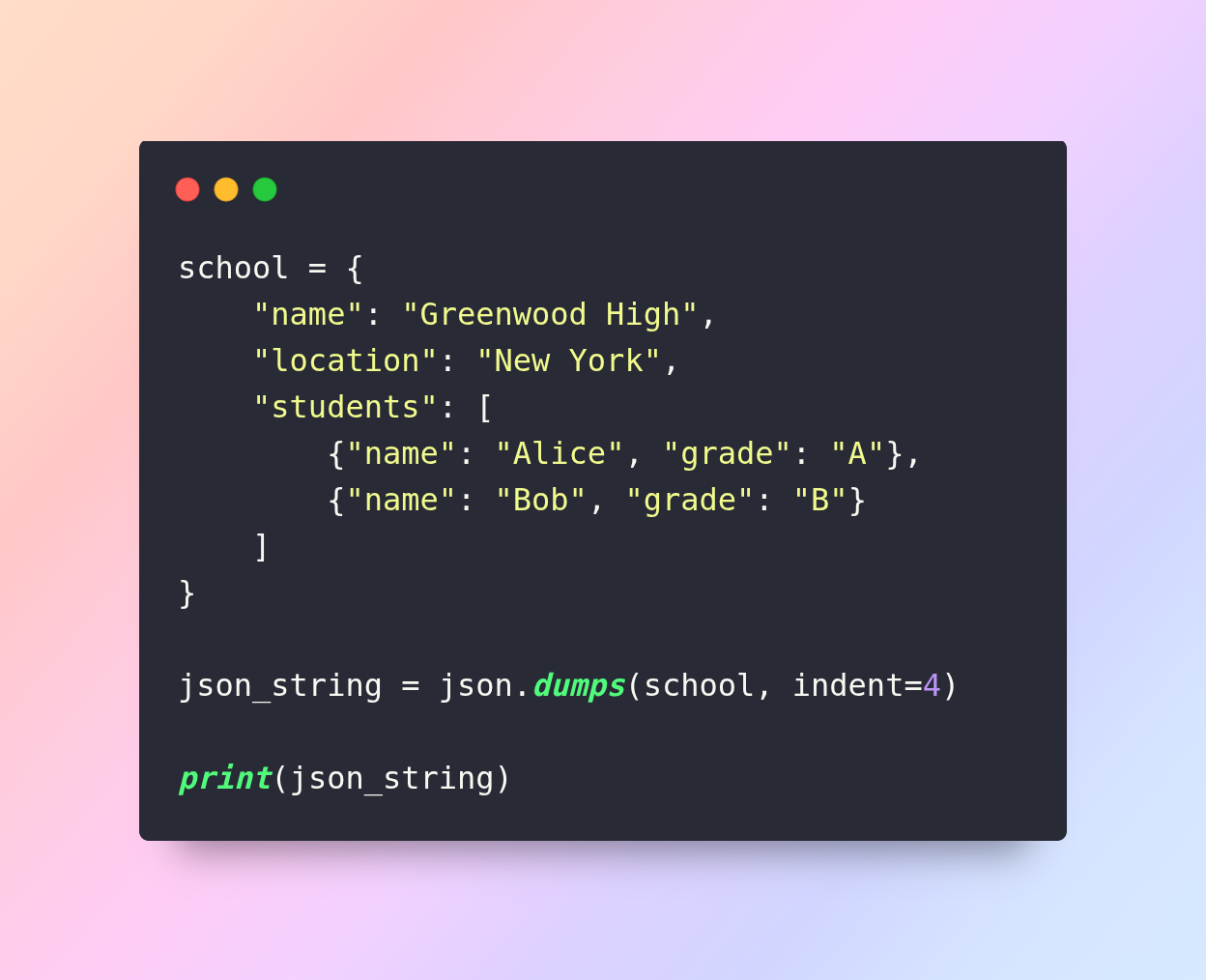
Tips for Beginners:
- Use indentation for readability.
- Convert tuples or sets to lists before serialization.
- Test nested structures carefully to avoid errors.
Real-World Use Cases
1. Saving Configuration Files
Many Python apps store user settings, themes, or preferences in JSON:
2. Sending and Receiving Data from APIs
Python often interacts with REST APIs that require JSON:
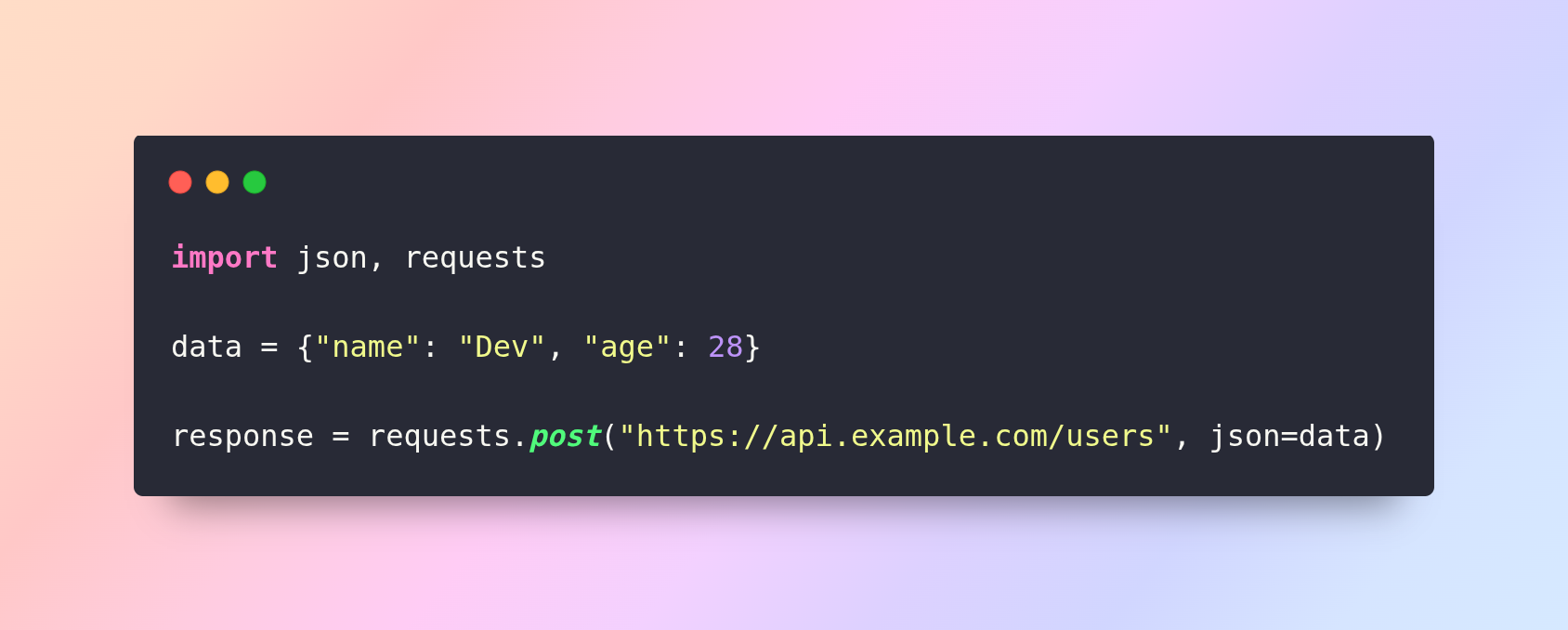
3. Logging and Auditing
Structured JSON logs are easier to analyze, filter, and visualize in tools like ELK Stack or Splunk.

4. Working with Web Apps
Front-end frameworks like React or Angular consume JSON from Python backends to render data dynamically.
Common Mistakes and How to Avoid Them
1. Non-Serializable Objects
- Problem: JSON cannot store sets, tuples, or custom classes.
- Solution: Convert them to lists or implement a custom encoder.
2. Encoding Issues
- Problem: Special characters can cause errors.
- Solution: Always use encoding="utf-8" and ensure_ascii=False.
3. Misunderstanding Python Types vs JSON Types
- Problem: Python None becomes null in JSON; tuples and sets are unsupported.
- Solution: Convert unsupported types before serialization.
4. Tips for Debugging Errors
- Use try-except blocks around json.dumps() to catch serialization errors.
- Validate JSON with online tools or Python’s json.loads().
Advanced Tips and Techniques
1. Pretty-Printing JSON
Use indent and sort_keys for debugging or creating readable files.
json_string = json.dumps(person, indent=4, sort_keys=True)
2. Compressing JSON for Network Transfer
Use separators to remove unnecessary whitespace:
json_string = json.dumps(person, separators=(',', ':'))
3. Custom Serialization with object_hook
Handle custom Python objects by defining serialization logic:
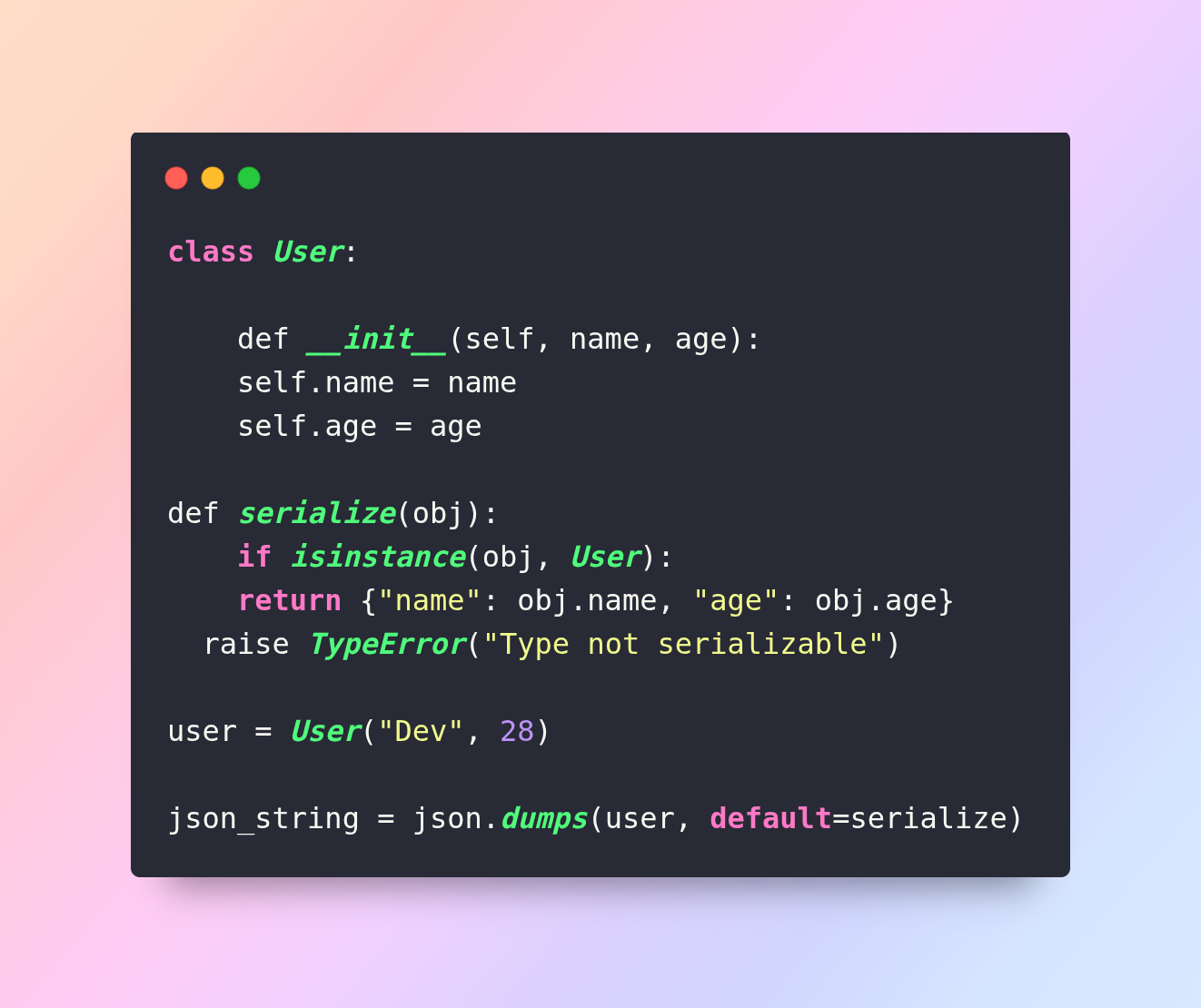
4. Using JSON in Multi-Language Applications
Python can exchange JSON with JavaScript, Java, C#, or Go, ensuring cross-platform compatibility.
Exercises for Beginners
- Convert a dictionary of students and grades to JSON
- Create a JSON configuration file for a Python app
- Read data from a public API and save it as a JSON file
These exercises reinforce real-world skills in Python JSON serialization.
Conclusion
Converting Python dictionaries to JSON is a foundational skill for Python developers. By understanding the basic techniques, best practices, and common pitfalls, beginners can handle data efficiently, whether it’s for APIs, web apps, configuration files, or logs.



.jpg)
.jpg)
.jpg)
